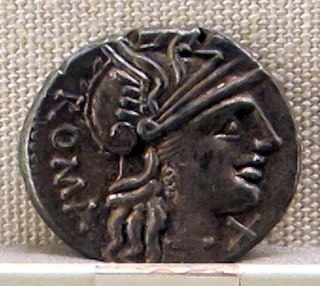Related Research Articles

The gens Minucia was an ancient Roman family, which flourished from the earliest days of the Republic until imperial times. The gens was apparently of patrician origin, but was better known by its plebeian branches. The first of the Minucii to hold the consulship was Marcus Minucius Augurinus, elected consul in 497 BC.
The gens Afrania was a plebeian family at Rome, which is first mentioned in the second century BC. The first member of this gens to achieve prominence was Gaius Afranius Stellio, who became praetor in 185 BC.
The gens Decia was a plebeian family of high antiquity, which became illustrious in Roman history by the example of its members sacrificing themselves for the preservation of their country. The first of the family known to history was Marcus Decius, chosen as a representative of the plebeians during the secession of 495 BC.
The gens Alliena or Aliena was a minor plebeian family of the Roman Republic. The first member of the gens to achieve prominence was Lucius Alienus, plebeian aedile in 454 BC. However, the family then slipped into obscurity for several centuries, emerging once more in the first century BC.
The gens Caelia was a plebeian family at ancient Rome. The nomen Caelius is frequently confounded with Coelius and Caecilius, with some individuals referred to as Caelius in manuscripts, while appearing as Coelius or Coilius on coins. Although the Caelii asserted their great antiquity, none of them attained any of the higher offices of the Roman state until the praetorship of Publius Caelius in 74 BC, and the first of this gens who obtained the consulship was Gaius Caelius Rufus in AD 17. The emperor Balbinus was a descendant of the Caelii.

The gens Canuleia was a minor plebeian family at ancient Rome. Although members of this gens are known throughout the period of the Republic, and were of senatorial rank, none of them ever obtained the consulship. However, the Canuleii furnished the Republic with several tribunes of the plebs.
The gens Sextia was a plebeian family at ancient Rome, from the time of the early Republic and continuing into imperial times. The most famous member of the gens was Lucius Sextius Lateranus, who as tribune of the plebs from 376 to 367 BC, prevented the election of the annual magistrates, until the passage of the lex Licinia Sextia, otherwise known as the "Licinian Rogations," in the latter year. This law, brought forward by Sextius and his colleague, Gaius Licinius Calvus, opened the consulship to the plebeians, and in the following year Sextius was elected the first plebeian consul. Despite the antiquity of the family, only one other member obtained the consulship during the time of the Republic. Their name occurs more often in the consular fasti under the Empire.

The gens Sergia was a patrician family at ancient Rome, which held the highest offices of the Roman state from the first century of the Republic until imperial times. The first of the Sergii to obtain the consulship was Lucius Sergius Fidenas in 437 BC. Despite long and distinguished service, toward the end of the Republic the reputation of this gens suffered as a result of the conspiracy of Catiline.

The gens Considia was a plebeian family at ancient Rome. The Considii came to prominence in the last century of the Republic, and under the early Empire, but none of them rose any higher than the praetorship.

The gens Juventia, occasionally written Jubentia, was an ancient plebeian family at Rome. After centuries of obscurity, the gens emerges into history with the appearance of Titus Juventius, a military tribune, in the beginning of the second century BC. The first of the Juventii to obtain the consulship was Marcus Juventius Thalna in 163 BC. But the family is renowned less for its statesmen than for its jurists, who flourished during the second century AD.
The gens Lucceia, occasionally Luceia or Luccia, was a plebeian family at Rome, which flourished during the final century of the Republic and under the early Empire.

The gens Munatia was a plebeian family at Rome. Members of this gens are first mentioned during the second century BC, but they did not obtain any of the higher offices of the Roman state until imperial times.

The gens Neria was a minor plebeian family at Rome. Members of this gens are first mentioned in the time of Caesar, when Gnaeus Nerius was quaestor, but few if any others are known to have held Roman magistracies. Many Nerii are known from inscriptions. A coin issued by the quaestor Nerius depicts the head of Saturn on the obverse, and standards labeled with the names of the consuls on the reverse, perhaps alluding to Caesar having broken open the treasury, or showing the legitimacy of the Senate to the legions against the rebellion of Caesar.
The gens Numeria was a minor plebeian family at ancient Rome. Few of its members held any of the higher offices of the Roman state.
The gens Petreia was a minor plebeian family at ancient Rome. Members of this gens are first mentioned toward the end of the second century BC, and several were distinguished as soldiers, but none of them ever attained the consulship.
The gens Pomptina was a minor plebeian family at ancient Rome. The gens is best known from Gaius Pomptinus, praetor in 63 BC, who helped suppress the conspiracy of Catiline, and later defeated the Allobroges. Few of the Pomptini appear in history, but others are known from inscriptions.
The gens Pontilia was an obscure plebeian family at ancient Rome. Hardly any members of this gens appear in history, but a number of them are mentioned in inscriptions.
The gens Staia was an obscure plebeian family at ancient Rome. Few members of this gens are mentioned by ancient writers, but a number are known from inscriptions. The most illustrious of the Staii was Lucius Staius Murcus, governor of Syria in 44 BC, and a military commander of some ability who served under several leading figures of the period.
The gens Tremellia was a minor plebeian family at ancient Rome. Members of this gens are first mentioned towards the end of the Second Punic War, but the highest rank ever attained by any of the Tremellii under the Republic was that of praetor. After falling into obscurity during the first century BC, the fortunes of this family briefly revived under the Empire, when Gnaeus Tremellius was appointed consul suffectus in AD 21, during the reign of Tiberius.
The gens Titinia was a minor plebeian family at ancient Rome. Members of this gens are mentioned as early as the time of the decemvirs, but only a few held any magistracies, and none of them ever attained the consulship.
References
- 1 2 Dictionary of Greek and Roman Biography and Mythology, vol. I, p. 947 ("Decimius").
- ↑ Chase, pp. 128, 130 (as "Decumius").
- ↑ Chase, p. 110.
- ↑ Livy, xxii. 24.
- ↑ Livy, xlii. 19.
- ↑ Livy, xlii. 37, 45.
- ↑ Hirtius, De Bello Africo, 34.
- ↑ Cicero, Epistulae ad Atticum, iv. 16.
- ↑ CIL VIII, 1219, CIL VIII, 25845, CIL VIII, 26568
- ↑ PLRE, vol. 1, pp. 427–428.
- ↑ Livy, xxvii. 14, xxxix. 32, 38, 39.
- ↑ Broughton, vol. II, p. 559.
- ↑ Livy, xlii. 35, xliii. 11, 15, xliv. 19, xlv. 10.
- ↑ Willems, Le Sénat de la République Romaine, p. 375.
- ↑ Crawford, Roman Republican Coinage, p. 251.